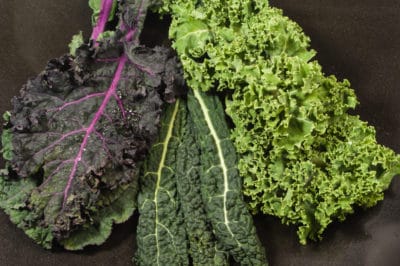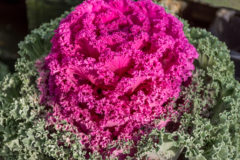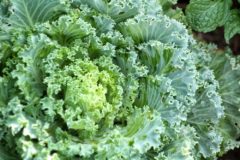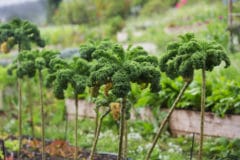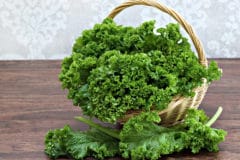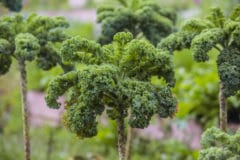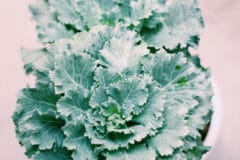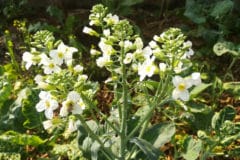Kale in the Flower Garden
The leaves of ornamental kale varieties can have a stronger, more bitter flavor than the varieties that are grown as vegetables, but ornamental kale is edible. Because of the stronger flavor, though, ornamental kale is usually used as a garnish rather than being eaten.
Just as you can add ornamental kale leaves to soups and stews, you can add varieties of kale that are grown as vegetables to your flower beds to provide unique and attractive foliage around your flowers. Taller varieties of kale can also serve as a backdrop for your flowerbed.
The main difference between the ornamental and vegetable varieties of kale is simply aesthetic. The varieties grown as ornamental kale have more interesting and more vivid colors and frillier leaves, so the ornamental varieties are simply “prettier.”
Japanese horticulturists developed many of the ornamental kales. The varieties include:
- Sparrow – fringed leaves with red and white varieties
- Kamone Coral Queen – fringed leaves with a center that can range from purple to coral
- Coral Prince – fringed leaves with a center that ranges from white to a pink flesh tone to salmon
- Peacock Kale – feathery, frilly, serrated leaves with red or white varieties
- Pigeon Kale – plain leaves with red, white, and purple varieties
- Chidori Kale – curly-leaf kale with purple or white centers
- Color Up Kale – plain leaves with white or magenta centers
- Osaka Kale – plain, scalloped-edged, bluish-green leaves with red, pink, or white centers
- Tokyo Kale – plain, blue-green, smooth-edged leaves with red, white, or pink centers
- Nagoya Kale – curly leaves with purple, yellow-green, or white centers
Just as cold weather sweetens the taste of kale that is grown as a vegetable, it also intensifies the colors of ornamental kale.
Kale in the Vegetable Garden
Kale’s Leaf Types
Kale has five leaf types:
- Plain-leaf – a leaf with no texture and a smooth or scalloped edge
- Bumpy-leaf – a leaf with an all-over bumpy texture; includes Lacinato Kale, which is also known as Tuscan Kale, Italian Kale, dinosaur kale, and Cavolo Nero
- Curly-leaf – a leaf with a deep or narrow ruffled edge; varieties include Blue Curled Kale, Dwarf Blue Curled Kale, Scots Kale, and similarly named varieties
- Rape kale
- Leaf-and-spear – an elongated leaf that is a cross between curly-leaf and plain-leaf kale
Kale’s Leaf Colors
Leaf colors include dark greens to light greens and violet-brown to violet-green. The center rosettes of ornamental kale varieties can be blue, violet, lavender, pink, white, or red.
Kale’s Growing Heights
Dwarf varieties of kale, such as Dwarf Blue Curled, may only be 12 inches high. Most varieties grow to be 2-3 feet tall. However, varieties like walking stick kale, which is also called tree kale, can grow as tall as 6-10 feet.
Kale’s Flavors
Curly-Leaf, Purple, and White Kale
If you are growing your kale to eat, appearances count in judging the attractiveness of the dish and its “plating”, as they say on the Food Network, but what matters to most people is the taste.
The kales with red or purple leaves and curly-leaf kales; such as Scots Kale, Blue Curled Kale, and others with similar names; share a sweet flavor tinged by an added pepperiness with an assertive, pungent, slightly bitter edge. White kale shares this flavor, as well.
The stems and ribs of the leaves of these kales are tougher and even more strongly flavored than the leaves, so remove them. You can, at your discretion, finely chop them and add them to your dish, or add them to your compost.
If you have a recipe that calls for kale without specifying a variety, though, these kales offer the sought after blend of flavors. Simply choose the one that gives your dish the most attractive look for the occasion.
If you want to use these varieties of kale in a salad, pick the leaves as baby kale, before they reach the size of your hand, when the flavor is milder. Save the larger leaves for soups, stews, and other cooked dishes. You can also use them as substitutes for spinach or cabbage to add variety to the flavor of your favorite dishes.
Lacinato or Tuscan Kale
Lacinato kale has a sweet or nutty sweet flavor that is milder than red, purple, white, or curly-leaf kales. It also lacks, or at least has less of, the bitter edge to its flavor. This is the variety to sauté or to serve raw in salads.
Red Russian Kale
Opinions differ on Red Russian Kale. Some feel that, although it adds a touch of pepperiness to kale’s generally sweet flavor, it is milder than white, purple, and curly-leafed kales. Others feel that the pepperiness places its flavor in the same taste category, even if it might be milder. How you decide to use Red Russian Kale is up to you and your family’s taste preferences.
Kale as a Seasoning All Year Long
If you would like to have kale around to season dishes all year long, you can. Dry the leaves in your oven or in a dehydrator to preserve it for long-term use.
